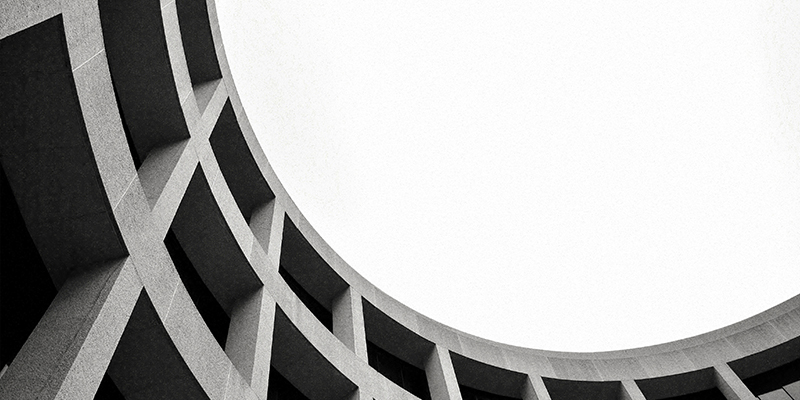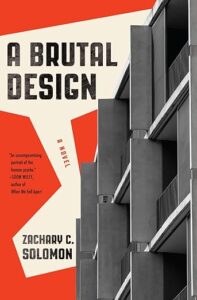In fiction, architecture has the ability to both contrive a novel’s setting and to participate as a character. When I began work on my novel A Brutal Design, it was Brutalism—a fitfully popular architectural style born in the 1950s and characterized by hulking, exposed concrete—that presented itself as the right architecture for my novel. But the more I researched the movement, the further my aspiration evolved: I didn’t only want to populate my novel with Brutalist designs; I wanted to write a Brutalist novel.
No other architecture is better suited to mirror the internal contradiction of character, the wrestling, the irreconcilability between who we are and who we aspire to be. No other movement produced work that is as stunning as it is grotesque. And no other movement contains within itself such an ocean between intent and result. Brutalism is the worst version of the most beautiful thing. A character walks through a vaulted cement lobby and feels the sheer weight and immensity of building around herself; she has no choice but to react to it; and you have no choice but to learn something new about her.
Brutalism shouldn’t be the de facto style of the buildings that decorate a novel’s urban environments; there is a time and place for buildings-as-characters that not all novels require. But I do believe that Brutalist offers a complexity that is reflective of the complexity of a decent novel. The best fiction contradicts itself. The best fiction towers into the sky while continuously struggling against relentless decay.
A Brutalist building is a tension continuously on the verge of resolution.Many of my favorite stories are characterized by dissonance, about how they do or do not resolve tension. A Brutalist building is a tension continuously on the verge of resolution. They are unsatisfying propositions. Yes, we want novels to satisfy us, but we just as often want them a little ambiguous, too. Not in the sense of did she, or did she not, commit the act, but in the sense that a good story invites us to bring our own prejudices and predilections into its dream. Our subjective vision of the world intermixes messily with the neatness of a novel. Whether she did or did not commit the act is irrelevant; what matters is how it makes us feel.
Brutalism was born out of the critical need to rebuild Europe after the mass infrastructural damage of World War II and to do so with limited resources and money. Concrete and brick were readily available but further refinement of these materials was cost-prohibitive and so they remained raw. This rawness became a principal feature. These buildings were erected to satisfy enormous need as quickly and equitably as possible. They represent socialist values: the raw material and exposed beams and supports became emblems of transparency, a celebration of the working class and the hands that set the concrete.
One of Brutalism’s most significant inspirations is Le Corbusier’s 1952 Unité d’Habitation in Marseille. This landmark building is full-service, high-density housing, in which there is a shopping district, medical facilities, and a kindergarten. A practical application of utopian belief, a kind of hermetic equity, in which the unhoused masses could find everything they needed within the walls of their building. This is a sealed universe: a dream of community delineated by walls. It is a story, full of characters and rich in setting.
As a symptom of modernism, Brutalism is aspirational. It is utopian fantasy incarnate, a future-focused philosophy of concrete. This is why Brutalist buildings have always been closely associated with totalitarianism, which is utopia greatly distorted. Nazi architect Albert Speer or the architects of Mussolini’s Italy hybridized modernist techniques with neoclassicism, creating a landscape of domineering structures intended not only to intimidate a populace, but to cleave a line through the epochs: the world was dark before fascism, but these proud buildings suggest that things are brightening. Though the fetishized and reviled Brutalist architecture of Europe and the Former Soviet Union postdates fascism, it nevertheless owes its existence to that totalitarian aesthetics. In this way, Brutalism never stood a chance; the association with fascism was too strong, the style too similar, the historical period too proximal. Like so many dreams of a better tomorrow, Brutalism was destined to fail.
The fact is that Mussolini and Le Corbusier are two sides of the same coin. For Hitler and Mussolini, the architectural division between past and future was the division between weakness and strength. The Brutalists, too, wanted to create a new history, but they were largely intent on knocking down the wall between unequal and equal. And yet: not for nothing did Le Corbusier idealize Nazi antisemitism and approve of Vichy anti-Jewish laws. Or consider American architect Philip Johnson, former director of MoMA’s architecture department, inaugural winner of the Pritzker Architecture Prize, and virulent Nazi propagandist. This is no bug of Brutalism that it should attract fascists; fascists are utopianists, but utopia isn’t always for everyone.
This association between fascism and modernism can be very hard to break, which is a large part of why Brutalism was never embraced. Indeed, the association was done no favors by the widespread use of Brutalism in institutional and social service buildings throughout the 1960s, 70s, and 80s: bus depots, government offices, blocks of affordable housing, schools, libraries. These places are weather-beaten now and in disrepair. They are despised not only for their style but because they represent an unkept promise. The government buildings house inert bureaucrats and plutocrats who have been toxified by greed. The transportation depots and libraries house amenities hobbled by budget cuts, eternally relegated to the lowest priority.
Brutalism is a hope dashed. You stand in the shadow of a Brutalist building and you feel the stirring of what could have been. But also: you are experiencing a sense of the sublime.
*We think of the sublime as something exquisitely pleasant or beautiful. We use the word to describe a wine or piece of meat or an aria. In fact, the sublime refers traditionally to vertiginousness, a feeling of powerlessness and puny humanity in the face of overwhelming vastness. The German Philosopher Arthur Schopenhauer insisted that the sublime was, in part, the “transcending of our own individuality.” He wrote that the sense of the sublime “arises through the consciousness of the vanishing nothingness of our own body in the presence of a vastness which…itself exists only in our idea, and of which we are as knowing subject…”
Schopenhauer was elucidating ideas of the sublime that had originated with Immanuel Kant. For Kant, there were three kinds of sublime, but for our purposes, we’re only concerned with one: the “terrifying sublime.” He wrote that the sublime “must always be large; simple; long,” a feeling that can be “accompanied with some dread or even melancholy.” The feeling of the sublime is both “a feeling of displeasure arising from the inadequacy of imagination” to remain reasonable and rational, and “a simultaneous awakened pleasure, arising from this very judgment of the inadequacy of sense.”
We stand in the shadow of a Brutalist structure and, if we’re lucky, we’re given the privilege of losing ourselves. The structure overwhelms us: the contradiction of its concrete, its utopian failure, its massiveness, uniformity, associative nearness to evil. We become lost and hopeless, terrified by the harsh reality of a complex thing.
Put your character face to face with a Brutalist structure and see how she reacts. She is on her way from plot point to plot point when, suddenly, she is confronted by a Brutalist structure. Its frank heaviness steals her breath away. Time slows.
What goes through her mind? People under duress reveal very true parts of themselves. You learn how she reacts to being so close but so far from perfection. Brutalism is a tease.
Great fiction teases its reader. We are teased by the hope of understanding, by an aphoristic moral, by the promise of entertainment, diversion. We’re teased by the hope of conclusion. A novel has to be complex to satisfy all of these hopes without succumbing to cliché.
Duma—the experimental settlement at the heart of my novel—needed Brutalism. Zelnik, an architecture student, wants to see himself represented in the buildings he designs, in the same way that what we see in the world is a reflection of our own minds. I felt that only Brutalism would work as the reflection of his character. Only Brutalism was sufficiently difficult.
A Brutal Design was partially written in Brutalist buildings. Being in those spaces helped me access Zelnik’s spiritual hopelessness. Entering these buildings boxed me into the same liminal space that my characters inhabit, between belief and nihilism or horror and delight. I was inspired when the building’s unwavering dejection of me contradicted its prayer for harmony. I wanted to swoon with despair but fall to my knees in supplication.
A central question of my book is whether Zelnik will find his missing Uncle. He is plagued by an uncertainty that I hope drags the reader through the sand till the end. Writing the novel in Brutalist spaces made that uncertainty real—the uncertainty between modernism and fascism, or finding and never finding. Zelink’s search for his uncle was based on an episode from my family history, but it was also based on the tension and tease of Brutalism. At some point you realize that knowing what happens in a novel is a luxury. Some writers indulge, others refrain. A Brutalist novel does both.
***


















